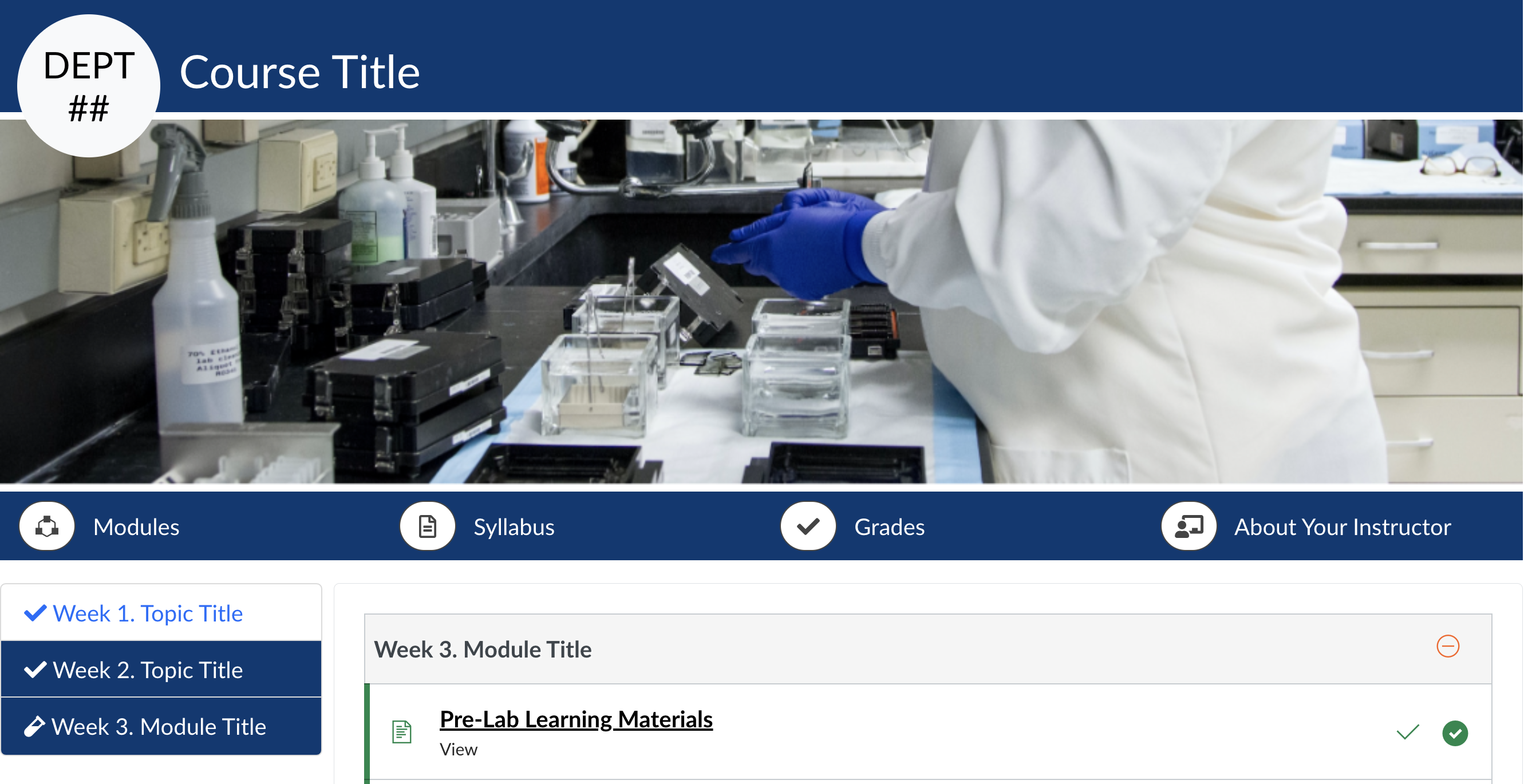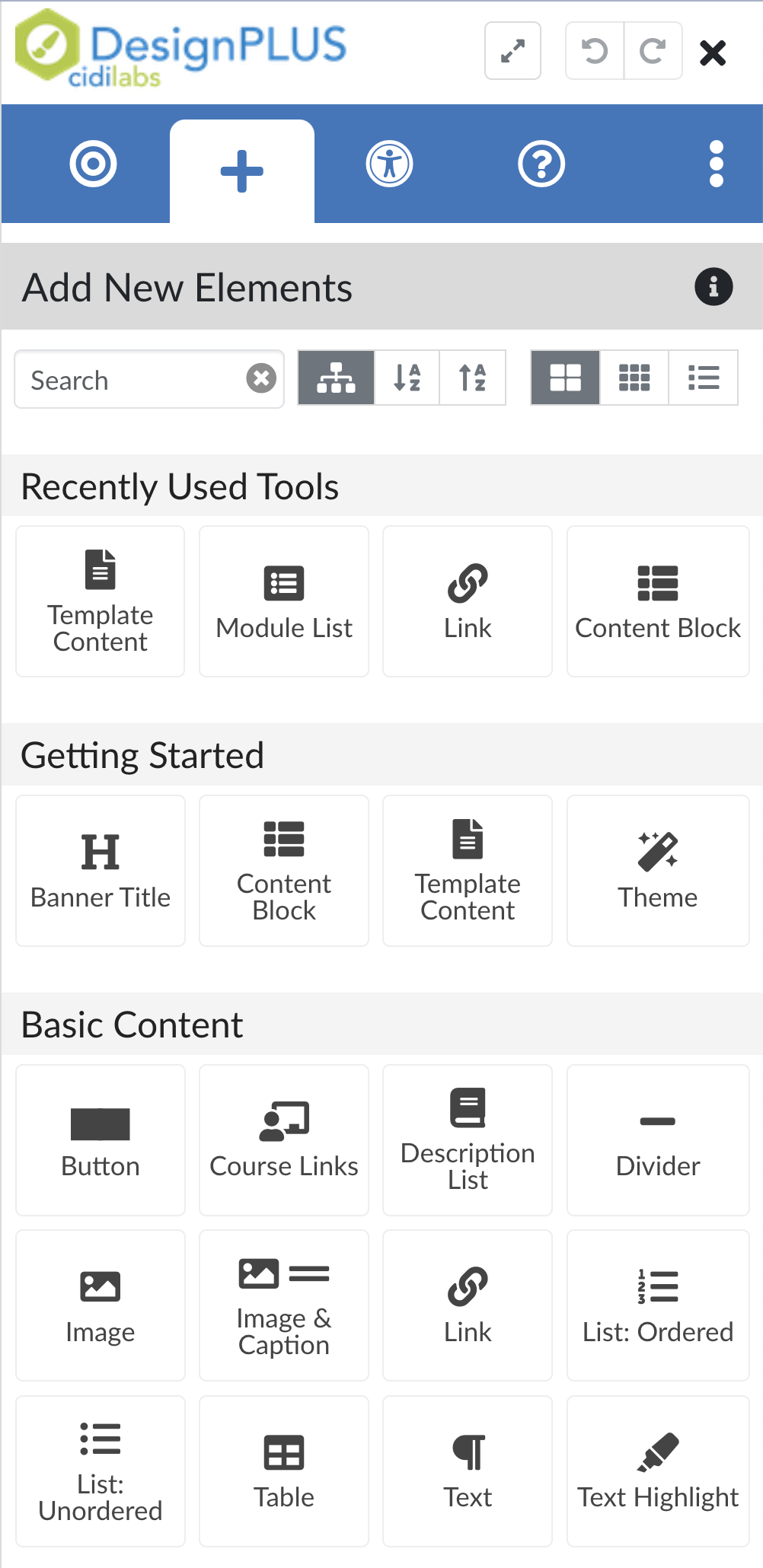
Just before our winter break, we shared with you some information about adding a homepage to your Canvas courses. However, if that information got lost in the commotion of finals week and the winter break, or if you’re thinking of ways to employ “plus-one” thinking into your courses this term, then utilizing DesignPLUS for your course homepage is a great place to start!
Benefits of using homepages
In Canvas, you are able to choose where you want your students to start when they first click into the course. One of the best things you can do for your online students is to create a unique, engaging, and intuitive homepage to greet them upon logging in.

Student retention
Hammond and Shoemaker (2014) found that “[m]any sources report higher dropout rates for online courses and programs as compared to traditional campus based courses and programs.” Shaikh and Asif (2022) examined reasons why students might not persist through their online higher education programs and categorized those factors into:
- Demographic attributes
- Academic experience
- Relevant technical and management skills
- Behavioral and psychological attributes
- Personal variables
As instructors, it is impossible to focus on every possible factor that could contribute to a student’s decision to drop out. However, by focusing on improving their academic experience through course design, we can mitigate the effects of other factors to help students persist through their education.
By implementing something as simple as a homepage into your Canvas course, you can immediately grab the attention of your students and improve their learning experience. If a homepage is learner-centered and intuitive, students will be able to navigate easily through the important parts of the course. Shaikh and Asif write that “[b]ad course organization, or at worst, lack of course organization and disconnected, illogical structures of the courses are linked with dropout decisions” and that “poor course design/organization affects learner satisfaction.” Providing clear places for students to begin their online learning experience or narrowing down their focus to specific modules on the homepage eliminates these issues.
One of the greatest ways in which course design can combat these negative outcomes is by instilling feelings of self-efficacy–or a “belief that one is capable of executing certain behaviors or achieving certain goals”–in students (Ormrod, 2011). Students need to feel that they can successfully and confidently move through their online courses without feeling overwhelmed or missing important information. If students feel they cannot even do that–which feels like a “basic” skill–then they are also more likely to believe that they cannot succeed when engaging with higher order tasks or complex content. A homepage is a simple way to empower online students.
This is especially true for first-generation college students. While all students benefit from these small design changes in an online course, “a significant interaction effect was found between the use of Design Tools [to create things like homepages] and students’ first generation status,” according to a report from The Center for Student Analytics at Utah State University (2019). The report goes on to say that “[t]his means that first-generation students achieved higher grades in courses taught by instructors who used Design Tools.” Reaching, retaining, supporting, and empowering this demographic of students is crucial and can be done, in part, by taking the time to welcome them into our online classes with well-designed course homepages.
Improved relationships
Last semester, we discussed the importance of social presence, especially in an online classroom. Wei, Chen, and Kinshuk (2012) write that a “lack of social presence may lead to a high degree of frustration, an unreasonably critical attitude toward the instructor’s effectiveness, and a lower level of affective learning.” Student success in an online environment is dependent upon the connections they are able to make, especially with their instructors. There are many strategies that can positively contribute to instructor social presence, and among those strategies are course homepages. While these pages serve as a clear starting place for students entering an online course, they also serve as an opportunity for instructors to showcase themselves and the unique aspects of their course right away. “Humanizing” yourself immediately sets the tone for your course and how students will engage with it.
Intuitive and engaging course design also leads to greater satisfaction in a course, as well as higher student outcomes. According to Joosten and Cusatis (2019), “Design and organization positively and significantly influenced students’ perceptions of learning and satisfaction as indicated in the analysis of the individual constructs of instructional characteristics.” Students who are engaged in a course that not only makes use of well-organized content but also aesthetically pleasing and intuitive navigation are more likely to feel that they are capable of greater learning and are more satisfied with their courses. They are likely to leave the course with positive feelings about their instructors as well as their online course and/or program. Joosten and Cusatis continue by asserting that “a strong effort should be made to design online courses,” especially in ways that are different from face-to-face courses.
Why DesignPLUS?

DesignPLUS is a toolbar supported by Cidi Labs that allows instructors to create highly customizable and accessible pages that can be used for assignments, content, and course homepages. When you make use of DesignPLUS to create a homepage, you can go beyond text and images and include the following features:
- Banner with course number and title
- Banner images
- A link grid, which can take students to important parts of the course with one click
- A module list, which can show students the current module as well as provide links to other modules in the course
And this is only a small fraction of the many features available in the DesignPLUS toolbar! Because of all the different tools available, you are able to fully customize your homepage (or any other pages) to suit your needs and make your course unique to you. For example, check out the DesignPLUS showcase to see how other institutions have made use of the sidebar for their online courses.
DesignPLUS also has a built-in accessibility checker that helps guide you through the process of creating accessible content, and in conjunction with UDOIT, can help you improve the accessibility of your online courses. Most of the features in DesignPLUS are mobile-friendly, too, so students using their phones or tablets will still benefit from all the features you’ve added.
How to get started
The COLRS staff is happy to help you make adding a homepage to your course your “plus one” project for this term. We encourage you to add the DesignPLUS Open Lab to your calendar and join us so we can answer any and all questions you have about DesignPLUS and homepages.
If you aren’t able to make it to the open lab but still want to try using a homepage for your course, we’ve designed a number of templates that are ready for you to bring into your course and use. You can find them on both Canvas Commons and as templates in the DesignPLUS toolbar. Once you’ve brought in the template and have edited it to your liking, you can set it as your homepage for students to see.
And, as always, if you have any questions, run into any trouble, or want to tell us about your experience, please reach out to us! We’re happy to help anytime!
References
Center for Student Analytics. (2019, Fall). Student Insights Report. (1). https://digitalcommons.usu.edu/cgi/viewcontent.cgi?article=1002&context=analytics_pubs
Hammond, D. E., & Shoemaker, C. (2014). Are There Differences in Academic and Social Integration of College of Agriculture Master's Students in Campus Based, Online and Mixed Programs? NACTA Journal, 58(3), 180-188. http://www.jstor.org/stable/nactajournal.58.3.180
Joosten, T., & Cusatis, R. (2019). A cross-institutional study of instructional characteristics and student outcomes: Are quality indicators of online courses able to predict student success? Online Learning, 23(4), 354-378. 10.24059/olj.v23i4.1432
Ormrod, J. E. (2011). Social cognitive views of learning. In Educational Psychology: Developing Learners (pp. 352-354). Prentice Hall PTR.
Shaikh, U. U., & Asif, Z. (2022, May 31). Persistence and Dropout in Higher Online Education: Review and Categorization of Factors. Front. Psychol., 13, 1-14. 10.3389/fpsyg.2022.902070
Wei, C.-W., Chen, N.-S., & Kinshuk. (2012, February 21). A model for social presence in online classrooms. Education Tech Research Dev, 60, 529-545. https://doi.org/10.1007/s11423-012-9234-9


